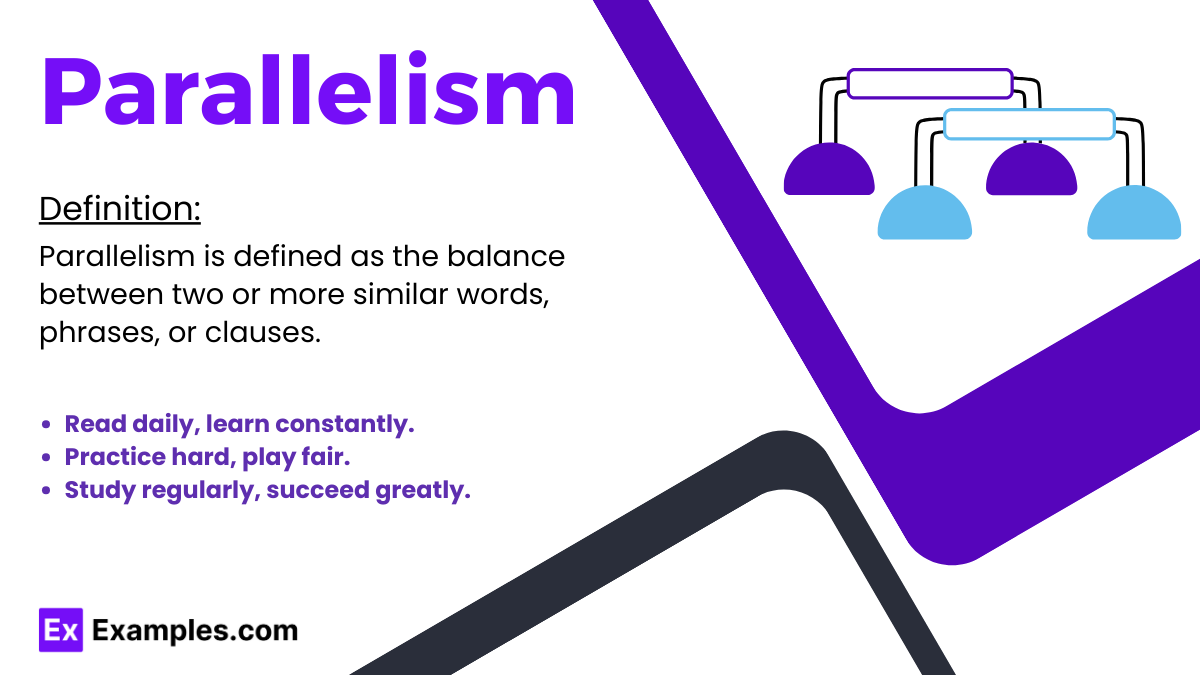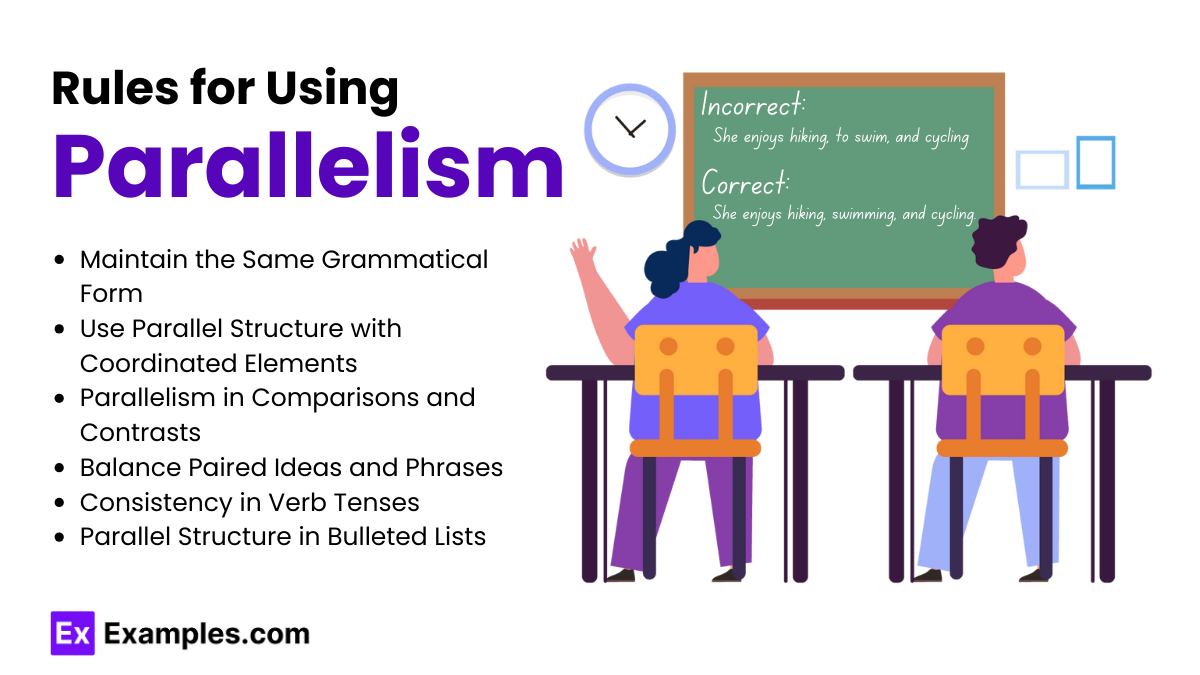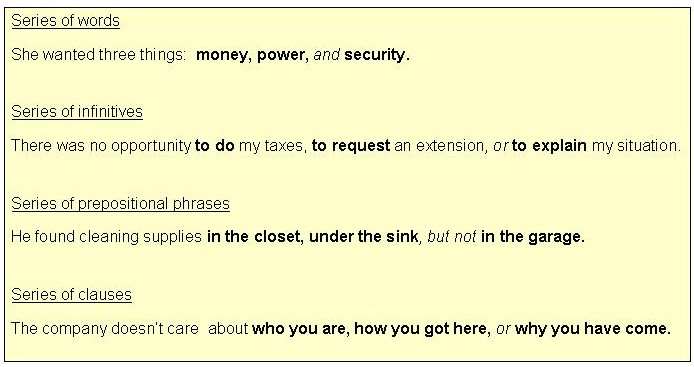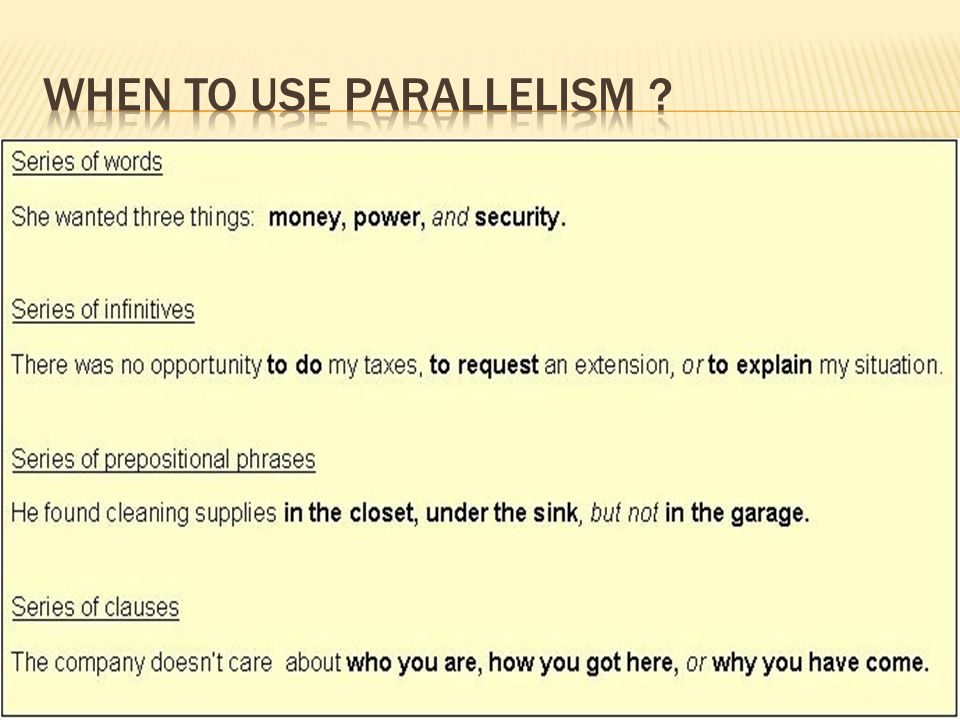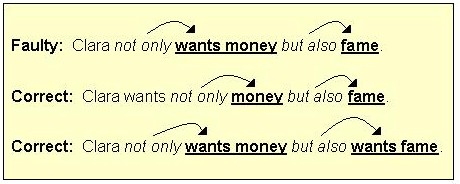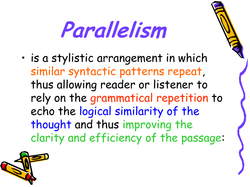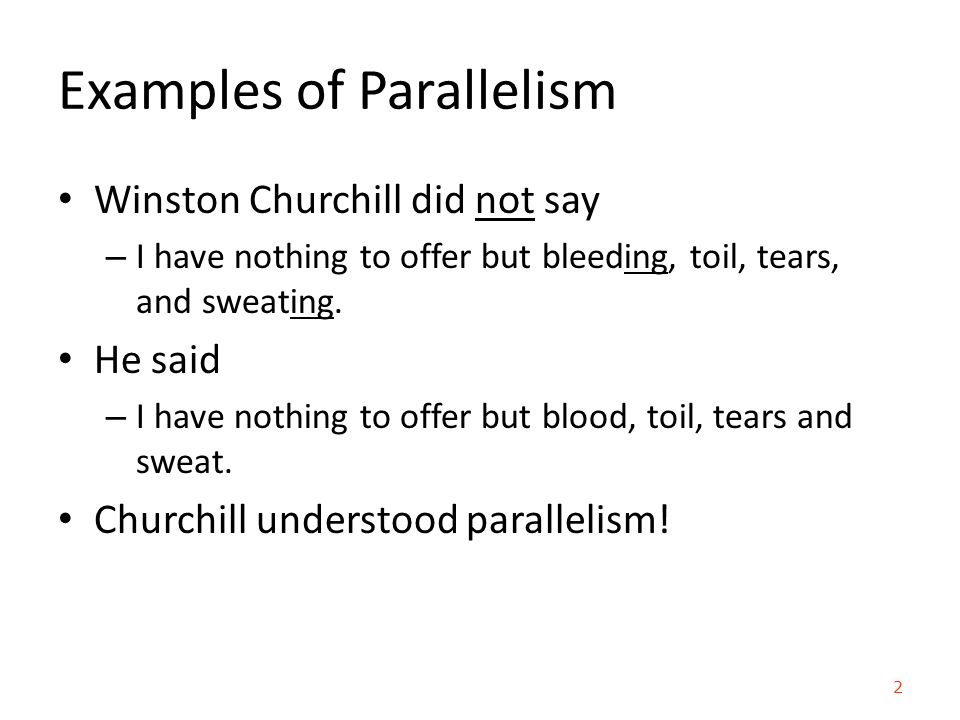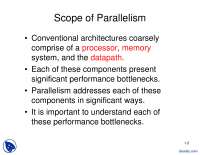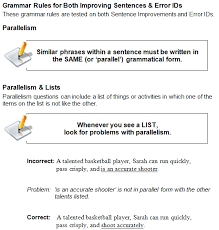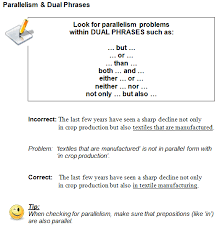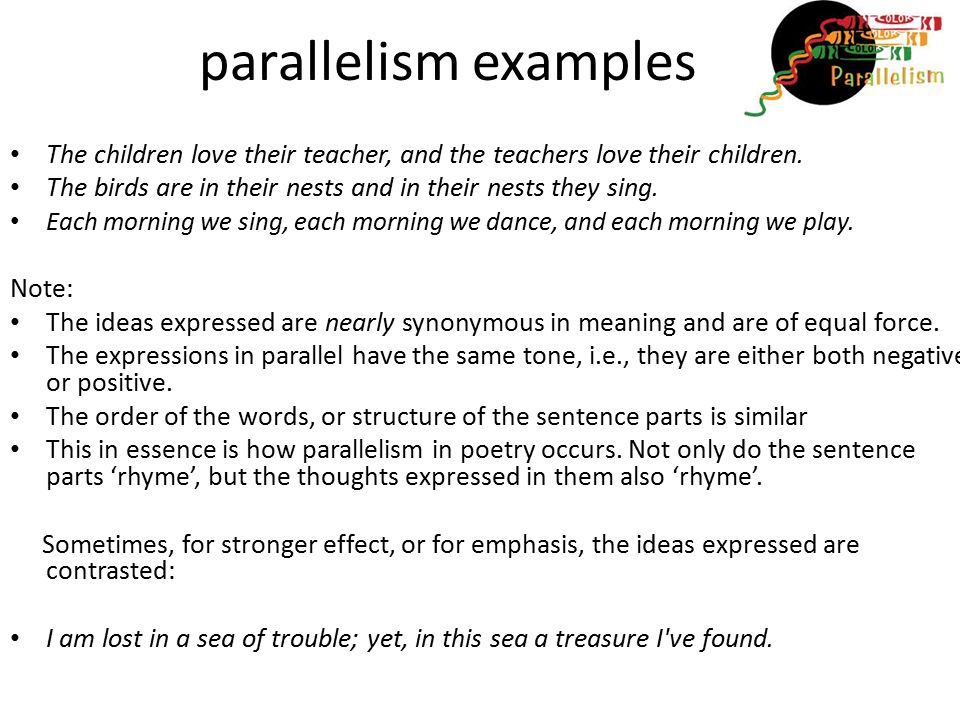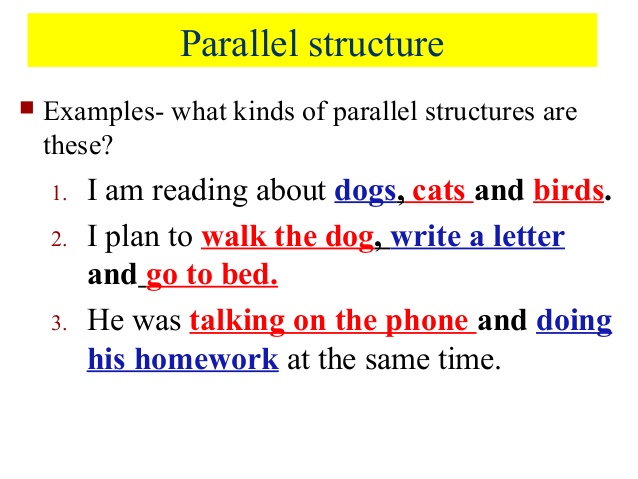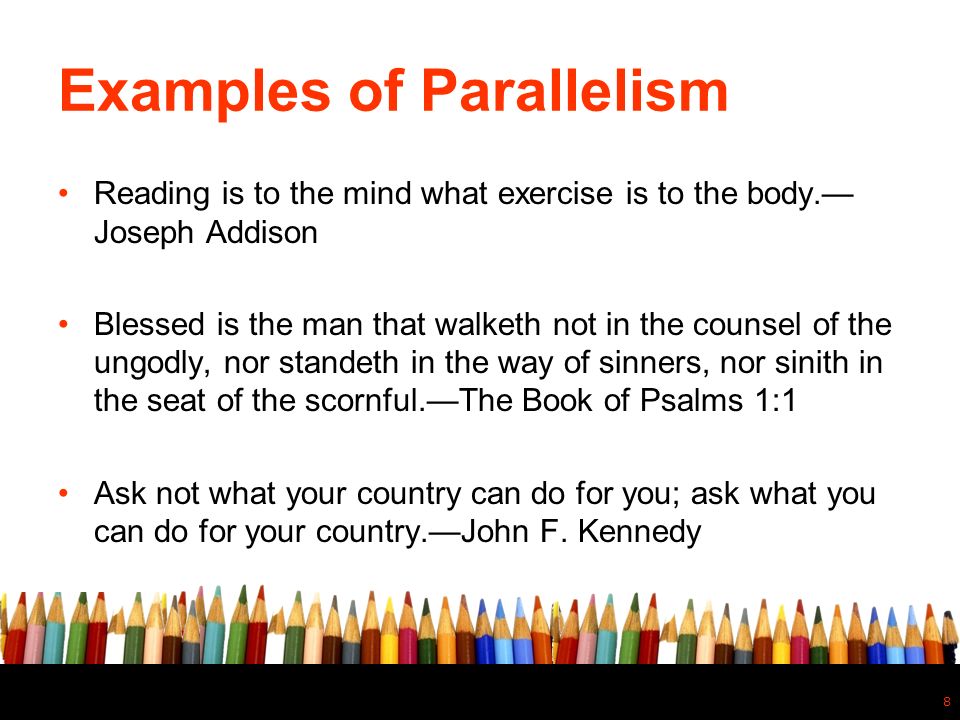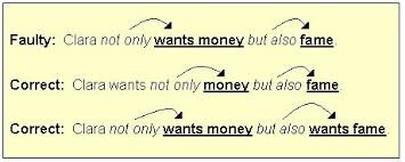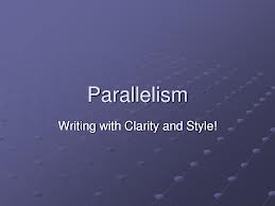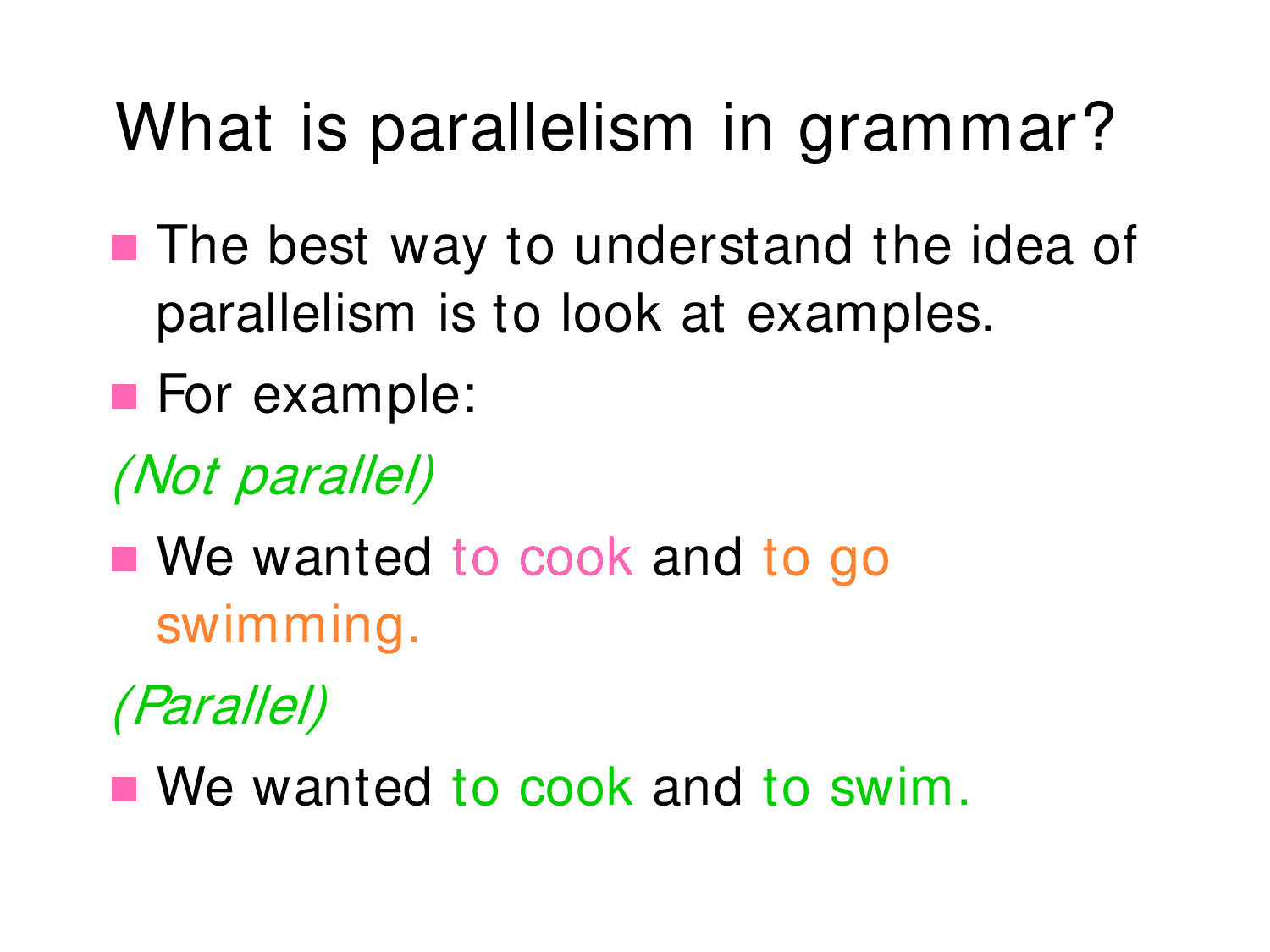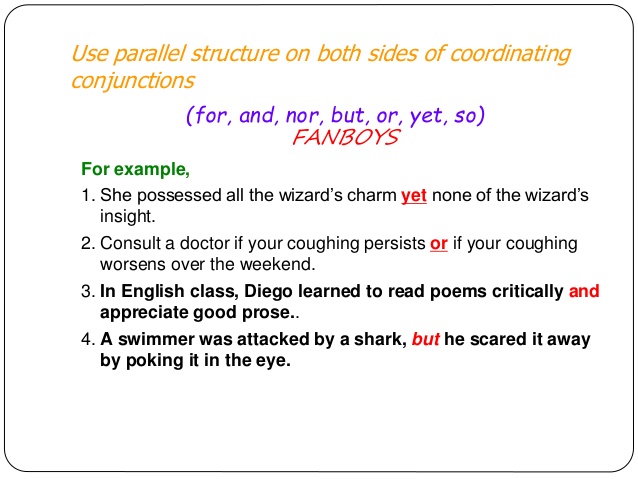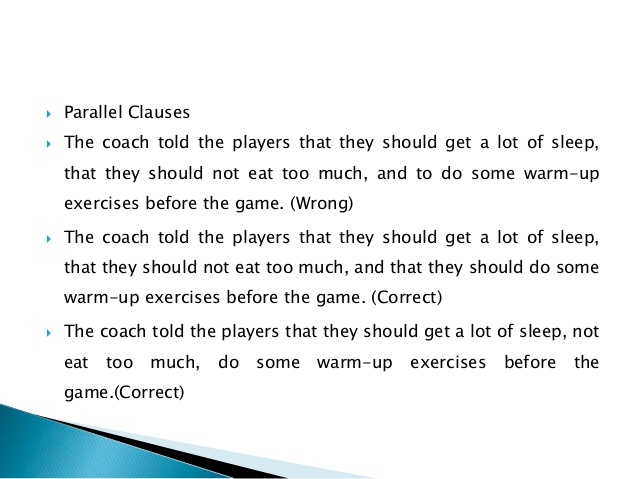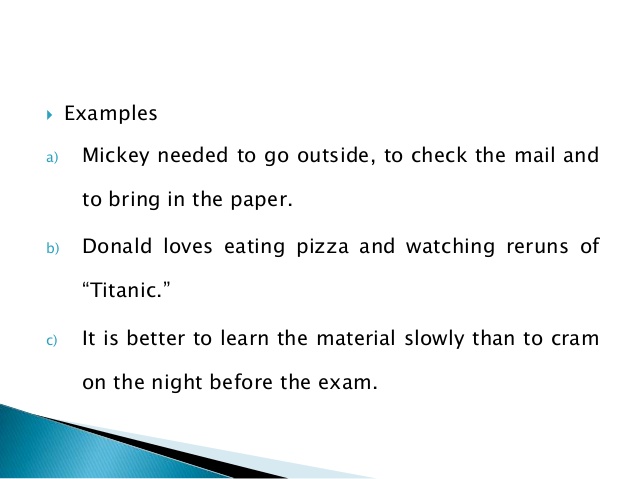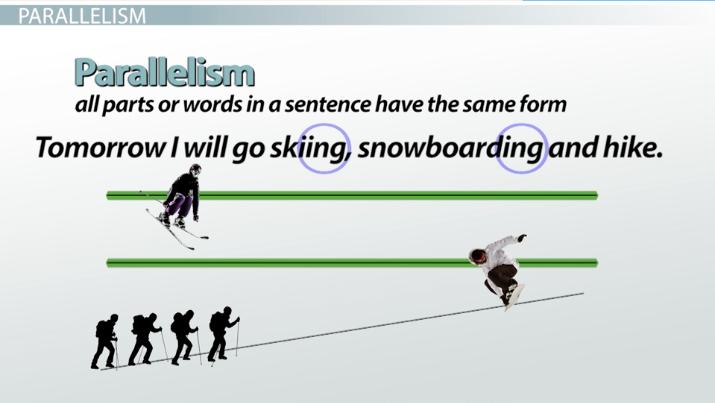50+ Parallelism Examples
Parallelism is defined as the balance between two or more similar words, phrases, or clauses. In grammar, it is also called parallel structure or parallel construction. Parallel construction prevents awkwardness in the sentence, promotes clarity of the message, and improves writing style and readability.
Take this sentence as an example: “Nancy likes playing the piano, the trumpet, and play the guitar.” Although technically, its grammar construction is not erroneous, you just know by reading the sentence that there is something wrong with how the words are arranged.
Compare that to this sentence: “Nancy likes the piano, the trumpet, and the guitar.” Both sentences tell us the same thing, that Nancy likes musical instruments. They are also both grammatically correct. However, the second sentence sounds much better than the second.
That is because the latter is a parallel sentence while the first isn’t. Parallelism is used to balance nouns with nouns, prepositional phrases with prepositional phrases, participles with participles, infinitives with infinitives, and clauses with clauses.
It is also used with elements joined by conjunctions, such as “My mother likes cooking and to read” compared to “My mother likes cooking and reading.” Parallelism is used when elements are in lists or in a series. For example:
“This task can be done individually, in pairs, or can be done in groups of four.”
“This task can be done individually, in pairs, or in groups of four.”
In these two sentences, the latter observes parallelism, which is why it sounds better than the first. Parallelism is also used when elements are being compared. It’s used with elements joined by a linking verb, or by linking words.
What is Parallelism?
Parallelism is a stylistic device used in writing and speech that involves using similar structures in related words, phrases, or clauses. This technique adds symmetry, effectiveness, and balance to the written and spoken word. It’s a powerful tool in making sentences clearer and more persuasive. Parallelism can be found in a wide range of contexts, from literature and poetry to speeches and advertisements, enhancing readability and making the content more memorable.
Types of Parallelism
Parallelism, a significant rhetorical device, enhances clarity, balance, and persuasiveness in writing and speech. It involves using similar grammatical structures in related words, phrases, or clauses. Understanding its types is crucial for effective communication. Here are the main types of parallelism:
1. Grammatical Parallelism: Involves matching grammatical structures. For example, verbs with verbs, nouns with nouns, or adjective phrases with adjective phrases, ensuring each element is in the same form.
- Example: “She likes hiking, swimming, and biking.”
2. Antithetical Parallelism: This type contrasts two ideas within the same sentence, often using a parallel structure to highlight the contrast.
- Example: “It was the best of times, it was the worst of times.”
3. Synonymous Parallelism: Commonly found in poetry and biblical literature, synonymous parallelism repeats the same idea in different words, reinforcing the concept.
- Example: “He slipped on the ice and fell on the slippery surface.”
4. Anaphora: A specific type of parallelism where the same word or phrase is repeated at the beginning of two or more successive sentences or clauses.
- Example: “Every day, every night, in every way, I am getting better and better.”
5. Epistrophe: The opposite of anaphora, epistrophe involves repeating the same word or phrase at the end of successive sentences or clauses.
- Example: “See no evil, hear no evil, speak no evil.”
6. Chiasmus: In chiasmus, the grammar of one phrase or clause is inverted in the next, often producing a mirror effect.
- Example: “Never let a Fool Kiss You or a Kiss Fool You.”
7. Isocolon: A balance of structure and length, isocolon involves using parallel elements that are similar not only in syntactical structure but also in length.
- Example: “Veni, vidi, vici.” (I came, I saw, I conquered.)
Rules for Using Parallelism
Parallelism, a powerful tool in both writing and speaking, requires a balance of similar structures within sentences or among parts of a sentence. To ensure clarity, cohesion, and elegance in your communication, follow these essential rules:
1. Maintain the Same Grammatical Form
When constructing lists or series, ensure all items share the same grammatical structure. This rule applies to verb forms, nouns, adjectives, and any other parts of speech included in your series.
- Correct: “She enjoys hiking, swimming, and cycling.”
- Incorrect: “She enjoys hiking, to swim, and cycling.”
2. Use Parallel Structure with Coordinated Elements
For sentences using coordinating conjunctions (and, but, or, nor, for, yet, so), make sure the elements connected by these conjunctions are in parallel form.
- Correct: “He likes to play basketball and to run marathons.”
- Incorrect: “He likes playing basketball and to run marathons.”
3. Parallelism in Comparisons and Contrasts
When making comparisons or contrasts using words like “than” or “as,” ensure the structures compared are parallel.
- Correct: “Writing poetry is as much an art as painting is.”
- Incorrect: “Writing poetry is as much an art as to paint.”
4. Balance Paired Ideas and Phrases
For sentences that contain pairs of ideas or phrases (either/or, neither/nor, not only/but also), the structure on both sides of the pair should be parallel.
- Correct: “She is interested not only in chemistry but also in physics.”
- Incorrect: “She is not only interested in chemistry but also in physics.”
5. Consistency in Verb Tenses
When listing actions or describing sequences of events, keep verb tenses consistent to maintain parallelism.
- Correct: “Yesterday, I woke up early, ate breakfast, and went for a jog.”
- Incorrect: “Yesterday, I wake up early, ate breakfast, and went for a jog.”
6. Parallel Structure in Bulleted Lists
Ensure items in bulleted or numbered lists follow a consistent grammatical form for clarity and professionalism, especially in academic or professional writing.
- Correct:
- Reading for pleasure
- Writing daily journals
- Practicing mindfulness
How to Create Parallel Structure
Parallel structure is created by ensuring that each part of a sentence uses the same grammatical form. Here are key strategies to achieve parallelism:
With Lists or Series: When listing items, ensure each item is in the same form (e.g., all nouns, gerunds, or infinitive verbs).
- Correct: “Julia enjoys reading, writing, and skiing.”
- Incorrect: “Julia enjoys reading, to write, and skiing.”
With Paired Ideas: When connecting ideas with conjunctions (like and, or, not only…but also), make sure the ideas are presented in matching forms.
- Correct: “She is not only smart but also hardworking.”
- Incorrect: “She is not only smart but hardworking too.”
With Comparisons: When making comparisons using than or as, the elements compared should be in the same form.
- Correct: “Running is more challenging than swimming.”
- Incorrect: “Running is more challenging than to swim.”
Parallelism in Literature
Parallelism, a prominent literary and rhetorical device, plays a crucial role in literature by adding rhythm, balance, and clarity to the text. This stylistic technique involves using similar grammatical structures in two or more parts of a sentence or across sentences to create a pattern or emphasize a connection between ideas. In literature, parallelism is employed to enhance the aesthetic quality of prose and poetry, making it more memorable and impactful for the reader.
The Purpose of Parallelism in Literature
Parallelism serves several purposes in literary works:
- Emphasizes Relationships: By paralleling ideas or themes, authors highlight their relationships or contrasts, enhancing the reader’s understanding of the connections within the text.
- Creates Rhythm: Repetitive structures contribute to the musical quality of the prose or poetry, making it more pleasing and engaging.
- Builds Intensity: In narratives or poems, parallelism can be used to build momentum or intensity, leading up to a climax or reinforcing a theme.
- Aids Memorability: Parallel structures are easier to remember, making the lines or passages more likely to linger in the reader’s mind.
Examples of Parallelism in Literature
William Shakespeare’s “Julius Caesar”:
- “Brutus is an honorable man; so are they all, all honorable men.” This repetition emphasizes the sarcasm in Mark Antony’s speech, subtly undermining Brutus’s credibility.
Charles Dickens’s “A Tale of Two Cities”:
- “It was the best of times, it was the worst of times, it was the age of wisdom, it was the age of foolishness…” The opening lines use parallelism to juxtapose the contradictions of the era, setting the stage for the novel’s exploration of duality.
Martin Luther King Jr.’s “I Have a Dream” Speech:
- “I have a dream that my four little children will one day live in a nation where they will not be judged by the color of their skin but by the content of their character.” Though not a literary text in the traditional sense, this speech exemplifies how parallelism can powerfully convey aspirations and values, enhancing the emotional and persuasive impact.
How to Identify Parallelism in Literature
To identify parallelism, look for repeating structures within sentences or across multiple sentences. These can be lists of words, phrases, or clauses that share the same grammatical form. Parallelism often appears in items in a series, comparisons or contrasts, and in conjunctions that link ideas (e.g., “and,” “or,” “but”).
How to Create Parallelism in Your Writing?
Parallelism, a cornerstone of effective writing, involves using similar structures for phrases, clauses, or sentences that are related. This stylistic device enhances clarity, rhythm, and emphasis in text. Here’s a guide to creating parallelism, which can elevate your writing from good to great.
1. Identify Opportunities for Parallelism
- Lists and Series: Look for opportunities in lists or series of items or actions.
- Paired Ideas or Clauses: Identify sentences with conjunctions (e.g., and, or, but) that connect ideas.
- Comparisons and Contrasts: Use parallelism when making comparisons or contrasts, especially with “than” or “as.”
2. Use the Same Grammatical Form
Ensure that the elements you’re paralleling share the same grammatical form (noun with noun, gerund with gerund, infinitive verb with infinitive verb, etc.).
- Correct: “She likes reading, swimming, and dancing.”
- Incorrect: “She likes to read, swimming, and to dance.”
3. Apply Parallelism in Complex Structures
- In Comparisons: “She prefers running to walking.”
- With Correlative Conjunctions: Use parallel structures after conjunctions like “either…or,” “neither…nor,” “not only…but also.”
- “He will either attend the meeting or send a representative.”
4. Ensure Consistency in Tense and Voice
Parallel elements should maintain the same tense and voice for clarity and coherence.
- Correct: “The manager discussed the marketing plan, outlined the budget, and announced the launch date.”
- Incorrect: “The manager discussed the marketing plan, outlining the budget, and the launch date was announced.”
5. Parallelism in Rhetoric and Speech
For speeches or persuasive writing, parallelism can be a powerful rhetorical tool to emphasize points and make the message more memorable.
- “Ask not what your country can do for you — ask what you can do for your country.” – John F. Kennedy
6. Practice and Review
- Practice: Regularly incorporate parallelism in your writing.
- Review: After writing, go back to ensure that your parallel structures are correctly implemented.
7. Use Parallelism for Emphasis
To draw attention to particular ideas or themes, use parallel structures. This technique makes your writing more dynamic and persuasive.
Parallelism in Grammar
Parallelism in grammar refers to the use of similar structures in related words, phrases, or clauses within a sentence or among sentences. This technique ensures that elements of equal importance in a sentence are presented in a grammatically uniform way. Parallelism is crucial for creating clear and coherent writing that is easy for readers to follow and understand. It adds symmetry, balance, and rhythm to sentences, enhancing both their aesthetic appeal and readability.
How Parallelism Works
Parallelism can be achieved in several ways, including:
- Parallel Words: Using the same part of speech or grammatical form for each item in a list.
- Example: “She likes reading, writing, and painting.”
- Parallel Phrases: Ensuring phrases that serve the same function in a sentence are constructed in a similar manner.
- Example: “He was admired for his dedication to training, his commitment to excellence, and his respect for teammates.”
- Parallel Clauses: Using the same grammatical structure in clauses that are paired or in a series.
- Example: “The coach advised that we should eat healthily, that we should exercise regularly, and that we should get plenty of rest.”
The Importance of Parallelism
- Clarity and Coherence: Parallelism helps organize ideas more logically, making them clearer and easier to understand.
- Rhythm and Emphasis: It adds a pleasing rhythm to writing and can be used to emphasize the ideas being presented.
- Engagement and Persuasion: Parallel structures can make writing more engaging and persuasive by enhancing its stylistic quality and impact.
Recognizing and Correcting Parallelism Errors
To maintain parallelism, ensure that all elements in a series or comparison have the same grammatical form. A common error occurs when these elements are mismatched, disrupting the flow and clarity of the sentence.
- Non-Parallel Structure: “She enjoys to read, writing, and to paint.”
- Corrected Parallel Structure: “She enjoys reading, writing, and painting.”
Correcting such errors involves identifying the parts of a sentence that are intended to be parallel and then adjusting them so that they match in grammatical form.
Examples of Parallel Elements
Examples of Correct and Faulty Parallelism
Parallelism with Elements in a Series
When to Use Parallelism with Examples
Faulty and Correct Parallelism Examples
Parallelism Defined
Parallelism and Winston Churchill
Parallelism in Kennedy’s Inaugural Address
Scope of Parallelism
Parallelism and Lists
Parallelism and Dual Phrases
Repairing Faulty Parallelism
Parallel Examples with Notes
Parallel Structure Examples
Examples #6: I have a Dream speech by Martin Luther King Jr.
“I have a dream that one day this nation will rise up and live out the true meaning of its creed: ‘We hold these truths to be self-evident; that all men are created equal.’
“I have a dream that my four little children will one day live in a nation where they will not be judged by the color of their skin but by the content of their character.
“I have a dream today.”
This is the popular speech by Martin Luther King Jr. in which he repeats the phrase “I have a dream” several times. This phrase later became the title of the speech. This is a good example of parallelism.
Example #7: How do I Love Thee by Elizabeth Barrett Browning
“I love thee freely, as men strive for right.
I love thee purely, as they turn from praise.”
These two verses from the poem of Elizabeth Barrett Browning have been made parallel by the repetition of “I love thee.”
Example #8: Presidential Inauguration Speech by Barack Obama
“My fellow citizens: I stand here today humbled by the task before us, grateful for the trust you have bestowed, mindful of the sacrifices borne by our ancestors.”
In this speech, U.S. President Barack Obama uses structural parallelism in the bold phrases, giving his speech beauty.
Example #9: Richard II by William Shakespeare
“John of Gaunt:
This royal throne of kings, this scepter’d isle,
This other Eden, demi-paradise,
This fortress built by Nature for herself
Against infection and the hand of war,
This happy breed of men, this little world,
This precious stone set in the silver sea,
Which serves it in the office of a wall,
Or as a moat defensive to a house,
Against the envy of less happier lands,
This blessed plot, this earth, this realm, this England . . .”
In this famous monologue from William Shakespeare’s Richard II, the character John of Gaunt recites a list of England’s virtues. Each clause begins with “this” and then includes yet another image of just how perfect John of Gaunt seems to consider England to be. It is, to him, a “demi-paradise,” a “precious stone,” a “blessed plot,” and so forth.
This parallelism is therefore also an example of anaphora. He ends the monologue, however, by contrasting all these paradisiacal images with the fact that England has now tarnished its beauty by setting out to conquer other nations. Thus there is parallelism in the entire passage that ends with the antithesis of England “bound in with shame, / With inky blots and rotten parchment bonds.”
Example #10: Annabel Lee by Edgar Allen Poe
“I was a child and she was a child,
In this kingdom by the sea,
But we loved with a love that was more than love—
I and my Annabel Lee—
With a love that the winged seraphs of Heaven
Coveted her and me.”
Edgar Allen Poe uses parallelism in many of his poems, including this beautiful poem. The first line of this stanza contains the repetition of “was a child.” As parallelism, this serves to show that both the speaker and Annabel Lee were young when they first fell in love, but that their youth did not negate the depth of their love. The parallelism in this stanza creates rhythm and gives deeper meaning to the love that he and Annabel Lee shared.
Examples of Parallelism
Examples of Parallelism in Writing
Parallelism
Correct and Incorrect Parallelism
Example #11: The Things They Carried by Tim O’Brien
“To generalize about war is like generalizing about peace. Almost everything is true. Almost nothing is true.”
Tim O’Brien’s marvelous story collection The Things They Carried has numerous examples of parallelism. Most notably, perhaps, is the title story in which O’Brien lists off the different items soldiers in the Vietnam War carried. That example of parallelism creates drama in the inanimate that begins to tell their own story. This excerpt shows a brilliant usage of parallelism in just three short sentences. O’Brien contrasts war and peace, as well as the concepts of truth and illusion.
Example #12: From Blossoms by Li-Young Lee
“From laden boughs, from hands,
from sweet fellowship in the bins,
comes nectar at the roadside, succulent
peaches we devour, dusty skin and all,
comes the familiar dust of summer, dust we eat.
O, to take what we love inside,
to carry within us an orchard, to eat
not only the skin, but the shade,
not only the sugar, but the days, to hold
the fruit in our hands, adore it, then bite into
the round jubilance of peach.”
This lovely poem by Li-Young Lee has many instances of repetition. There is parallelism in the first stanza of reciting where the peaches have come from: “From laden boughs, from hands, from sweet fellowship in the bins.” The connection of these three images shows that the peaches are not just the work of nature, but also the work of humans picking them and providing them at roadside stands.
Lee goes on to provide parallelism in the next stanza with the similarly structured lines “not only the sin, but the shade, / not only the sugar, but the days.” Again, he gives credit to all the elements that have formed this fruit.
What Is Parallelism in Grammar?
Understanding Parallelism
Parallel Structure in Grammar
Parallel Clauses
Examples of Parallel Sentences
Rules of Parallelism
Parallelism Mistakes
Parallelism mistakes occur when the structure of phrases or clauses within a sentence fails to maintain a consistent pattern. These errors can disrupt the flow of writing, making it awkward or difficult to understand. Recognizing and correcting parallelism mistakes is crucial for enhancing clarity, readability, and overall effectiveness of communication. Here are some common types of parallelism mistakes and tips on how to correct them:
1. Mismatched Verb Forms
Mistake: Mixing different verb forms or tenses in a list or comparison.
- Incorrect: “She likes running, to swim, and biking.”
Correction: Ensure all verbs are in the same form.
- Correct: “She likes running, swimming, and biking.”
2. Inconsistent List Items
Mistake: Combining different types of grammatical structures in a list.
- Incorrect: “For our trip, we packed sandwiches, fruit, and are bringing water bottles.”
Correction: Make all items in the list follow the same grammatical structure.
- Correct: “For our trip, we packed sandwiches, fruit, and water bottles.”
3. Uneven Comparisons
Mistake: Using unlike forms in comparisons.
- Incorrect: “Writing a novel is more difficult than to publish it.”
Correction: Use parallel structure in both sides of the comparison.
- Correct: “Writing a novel is more difficult than publishing it.”
4. Faulty Paired Elements
Mistake: Pairing elements with different structures (often seen with conjunctions like “not only… but also,” “either… or,” “neither… nor”).
- Incorrect: “She is not only skilled in coding but also in to play the piano.”
Correction: Ensure paired elements are of the same form.
- Correct: “She is skilled not only in coding but also in playing the piano.”
5. Inconsistent Prepositional Phrases
Mistake: Combining prepositional phrases with different structures.
- Incorrect: “He was famous for his performances on stage and in writing scripts.”
Correction: Align the structure of prepositional phrases.
- Correct: “He was famous for his performances on stage and for writing scripts.”
Avoiding Parallelism Mistakes
To avoid parallelism mistakes, consider the following tips:
- Review Lists and Comparisons: Pay special attention to lists, comparisons, and paired elements, ensuring they follow the same grammatical structure.
- Read Aloud: Sometimes, reading a sentence aloud can help identify awkward or inconsistent structures.
- Revise for Consistency: If you spot a parallelism error, revise the sentence to align the grammatical structures of the parallel elements.
Parallelism in Rhetoric
Parallelism is a potent rhetorical device used to enhance the persuasiveness and memorability of speech or writing. By employing similar grammatical structures within sentences or across different parts of a text, speakers and writers can create patterns that resonate with their audience, adding emphasis, clarity, and aesthetic appeal to their messages. This technique, rooted in the principles of balance and repetition, is a cornerstone of effective rhetoric.
Purpose of Parallelism in Rhetoric
Parallelism serves several key purposes in rhetoric:
- Emphasis: It highlights key points, making them stand out and thus more memorable to the audience.
- Clarity: By organizing ideas in a symmetrical structure, parallelism makes arguments clearer and easier to follow.
- Rhythm: The repetition of structures can produce a rhythmic flow, enhancing the oral impact of speeches or the reading experience of written texts.
- Balance: Parallelism introduces a sense of balance and order in discourse, which can be aesthetically pleasing and persuasive.
Forms of Parallelism in Rhetoric
Parallelism can manifest in various forms, each suited to different rhetorical aims:
- Anaphora: The repetition of a word or phrase at the beginning of successive clauses or sentences. Example: “We shall fight on the beaches, we shall fight on the landing grounds, we shall fight in the fields and in the streets…” (Winston Churchill).
- Epistrophe: The opposite of anaphora, involving the repetition of a word or phrase at the end of successive sentences. Example: “…government of the people, by the people, for the people, shall not perish from the earth.” (Abraham Lincoln).
- Antithesis: The juxtaposition of contrasting ideas in balanced phrases or clauses. Example: “It was the best of times, it was the worst of times…” (Charles Dickens).
- Isocolon: A sequence of sentences or clauses of exactly the same length and similar syntactical structure. Example: “Veni, vidi, vici.” (Julius Caesar).
Examples of Parallelism in Rhetorical Speeches
Many famous speeches have employed parallelism to great effect:
- Martin Luther King Jr.’s “I Have a Dream”: This speech is renowned for its use of anaphora, particularly in the repeated phrase “I have a dream,” which serves to unify the speech’s various visions of equality and freedom.
- John F. Kennedy’s Inaugural Address: Kennedy’s address contains multiple instances of parallelism, including the famous antithetical statement, “Ask not what your country can do for you—ask what you can do for your country.”
Crafting Parallelism in Your Rhetoric
To effectively use parallelism in rhetoric, consider the following tips:
- Identify Key Points: Use parallelism to highlight and reinforce the most important points in your argument or message.
- Maintain Grammatical Consistency: Ensure that the parallel elements share the same grammatical structure.
- Vary Your Approach: Experiment with different forms of parallelism to find what best suits your purpose and resonates with your audience.
- Practice Balance: While parallelism can be powerful, overuse can lead to monotony. Balance its use with varied sentence structures to maintain engagement.
FAQs
How do you identify parallelism?
To identify parallelism, look for elements in a sentence that are similar in structure or form. These can be words, phrases, or clauses that follow the same grammatical pattern. Consistent use of parallel structure across these elements is key to recognizing parallelism.
What is an example of parallelism for kids?
An example of parallelism for kids is: “I like to run, to jump, and to play.” This sentence shows parallelism because all the verbs are in the same form, making the sentence balanced and easy to understand.
What is wrong parallelism examples?
Wrong parallelism occurs when elements that should be parallel in structure are mismatched. For example: “She likes reading, to jog, and biking.” The correct parallel structure would be: “She likes reading, jogging, and biking.”
What does parallelism mean in vocabulary?
In vocabulary, parallelism refers to the use of components in a sentence that are grammatically the same or similar in construction, sound, meaning, or meter. It’s a stylistic device that enhances coherence and balance in writing or speech.
What does parallelism add to writing?
Parallelism adds clarity, balance, and elegance to writing. It makes ideas easier to follow and understand, enhances the rhythm of the text, and can make arguments more persuasive. Parallelism is a key tool for effective communication.
How do you fix parallelism in writing?
To fix parallelism in writing, ensure that all parts of your sentence that are meant to be parallel use the same grammatical structure. Adjust the non-conforming elements to match the form of the others, creating a balanced and coherent sentence
In Conclusion, Parallelism gives a sense of order to the thoughts we try to express in writing. It helps make sure that our statements are not only grammatically accurate, they are also pleasant to hear. It is a technique that not only writers should develop. Anyone who attempts to put pen to paper should try to hone their skills in constructing parallel structures.


